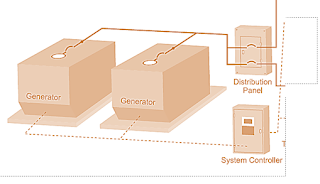Why generators are in parallel?
here are some of the summarized reasons:
1. Continuity of the service
2. Efficiency
3. maintenance and repair
4. Addition to plant ( provision or future expansion)
.
Efficiency
In an electrical power generating system the load fluctuates, usually reaching a minimum during the night and having its peak value during day time.And with several machines required to supply the load, it becomes necessary to operate them in parallel so that their combined outputs may be transmitted from the same bus bars over outgoing lines.
Continuity of the service
Continuity of the service is not only desirable but also economic necessity.
When the load upon the system is small, it is undesirable from the standpoint of efficiency to have a large generator lightly loaded. its better to have a smaller generator operating near full load. if a shift in a load is made from a large generator to a small one or vice versa, the operation must be carried through without interruption to service.
Expandability of the Plant
In expanding of the power supply system it is often difficult to plan for anticipated load growth. If load projections are too aggressive, initial capital expenditures may be higher than necessary. If load projections are too low, the facility may be left without reliable standby power or may require expensive generator upgrades. By parallel connections of generators expansion of the generating system is not too complicated.
Maintenance and repair
As for parallel generators, units can be taken out of service for repair or maintenance without losing standby power for critical circuits. This feature enhances reliability and reduces the need to bring a backup generator within the site. Even the failures of standby generators are not very common,the built-in redundancy of a parallel system provides multiple layers of protection for critical circuits.

nice post....
ReplyDeleteplease visit OUR PAGE ok!!
thank's....